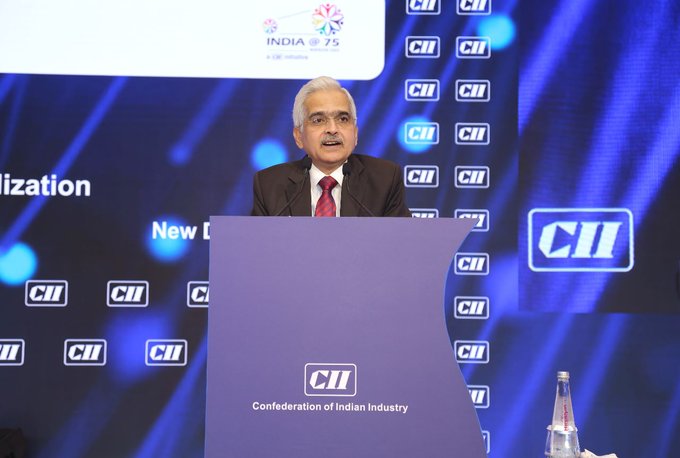
Staff Reporter
“India is witnessing a confluence of factors which is feeding into the India growth story. The RBI would, through a prudent approach, do its best to ensure financial stability in the system and create conditions for sustained economic growth,” Mr Shaktikanta Das, Governor, Reserve Bank of India (RBI), said at the Annual Session 2023 of the Confederation of Indian Industry (CII).
Addressing the session on ‘Future Frontiers: Competitiveness, Technology, Sustainability, Internationalization,’ the RBI Governor’s presentation pivoted around four major aspects, namely global economic backdrop, domestic scenario, inflation and RBI policy. On global growth, he said that the global economy is mired by geopolitical uncertainty, elevated inflation, volatile financial markets, including banking sector stress, food insecurity and debt distress, among others.
Mr Das noted that, on the upside, there has been a slow upturn in global growth, easing of supply chains, moderation of inflation, normalization of financial markets and reopening of Chinese markets, which have all improved sentiments, but the uncertainty continues.
Amidst global churn, the Indian economy has shown resilience and has created requisite buffers to meet geopolitical and domestic challenges. He added that the Indian economy is projected to grow at 6.5 per cent this year. Moreover, Mr Das added, moderate inflation, robust agriculture performance, predictions of normal monsoon, impressive services sector performance, rise in bank credit, revival of private investment and increase in capacity utilization by industry, among others, are the other major positives for the Indian economy.
On macroeconomic stability and the financial sector, the RBI Governor said that NPAs have reduced and the financial sector is resilient. Besides, India has the advantage of demography which would add to the country’s potential output. Mr Das that there are downside risks to growth from global deceleration, the El Nino factor affecting monsoons, etc., and that all of these factors will need to be handled cautiously.
Mr Das emphasized on the urgent need to ensure availability and access to technology. He stressed that the future belongs to technology and that industry has a major role to play in technology development. He said that the public and the private sectors should work together to be technology ready.
On inflation and RBI policy, the RBI Governor maintained that on inflation there is no room for complacency and that the situation requires a close watch. The course of monetary policy would depend upon the ground situation, which would determine whether the RBI would continue to maintain a pause in the rates.
On the policy approach of the central bank, Mr Das maintained that the role of the RBI is to be proactive, exercise prudence and to act in time. He assured that the RBI would ensure that there is sufficient liquidity in the system for sustaining economic activity. The country has sufficient forex reserves and the central bank has maintained the exchange rate of the rupee. It has allowed international trade settlement in rupee in 18 countries.
Mr Sanjiv Bajaj, President, CII, spoke about the excellent ‘jugalbandi’ between the RBI’s monetary policy actions and the government’s fiscal policy to emerge as the fastest-growing major economy in the world for the third successive year and is expected to retain this spot for the medium to long term.
Mr R Dinesh, President Designate, CII, during his concluding remarks, complimented the RBI Governor for his importance to technology and for ensuring sufficient systemic liquidity. He hoped that the RBI would continue the pause in rates.
